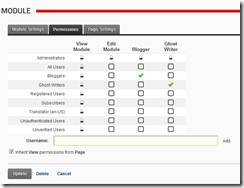|
If you were following along w/ any of the blog 5.0 betas, you may recall me mentioning Ghost Writers and Blogger permissions. Users who are given “Ghost Writer” permissions are capable of editing and creating new blog entries on behalf of other users in blogs that permit this. Users who are given “Bloggers” permissions are capable of creating their own blog and posting/editing entries in that blog. While the ‘Ghost Writer’ permission level is a completely new feature, the “Bloggers” permission level is a change in behavior versus previous blog module releases where blog authors had to be module editors. Upgrades will see no change in behavior but those who want to take advantage of these new features as well as simplify their blog management or if you are just installing Blog for the first time, you should read on.
|
 |
Exploring Module Permissions
If you go to the module settings of the main blog module (usually titled “View_Entry” when you first place the module on the page), you will notice there are two additional columns in the permissions grid: Blogger, Ghost Writer. In the example image I have Blogger associated with the “Bloggers” role and Ghost Writer associated with the “Ghost Writers” role. You can assign any roles you wish, there is no reason you must use the same roles I am using here (you could also assign individual users from here and not utilize roles at all). If you are upgrading from a previous blog module version, I recommend disabling the edit permissions ASAP on the module and moving to the “Blogger” role as a replacement.

What these permissions offer you:
- Blogger:
- Can create their own blog (only 1 per portal)
- Edit their own blog settings
- Edit and author all entries in their specific specific blog
- Ghost Writer:
- Post and edit entries in blogs that enable ghost writing
Authoring Modes
Authoring mode is a new per blog setting (note that is blog setting and NOT blog module setting) that takes advantage of the new module level permissions just discussed. There are three authoring modes available, the first of which is “Personal”. This is the default mode and it behaves like the blog module previously behaved. Users who are permitted to have a blog (ie. Blogger from above) can post entries in their own personal blog but not that of another user, just like before. Ghost writers, on the other hand, cannot post to personal blogs nor are they capable of creating their own blog.
The second mode, as you might have guessed, is Ghost Writer authoring mode. All this mode really does is permit other users (those assigned the “Ghost Writer” module permission) to post to any blog that runs in this authoring mode. In order for a ghost writer to post to a blog in ghost writer mode, they must be viewing the specific blog they wish to post to (because multiple blogs can exist in the same module and there would be no context to place them in the proper blog, likewise this is not supported via WLW for some of the same reasons). As the name implies, ghost writers post to the blog as the blog owner (meaning, the blog article is credited to the blog owner and not the ghost writing author).
The final mode is “All Bloggers”. This is a single blog that is owned by a single user (in a sense) but information about the specific blog owner is never displayed. The author who is credited as author in each blog entry varies based on who authored the blog post. This authoring mode allows any users assigned the “Blogger” permission the ability to post in these blogs (which means you could have more than one, although I recommend you utilize categories for that type of scenario). Ghost Writers are not permitted to post to blogs in “All Bloggers” authoring mode.

If you would like to download the 5.0 final release and try things out for yourself, you can do so here:
Download Blog 5.0